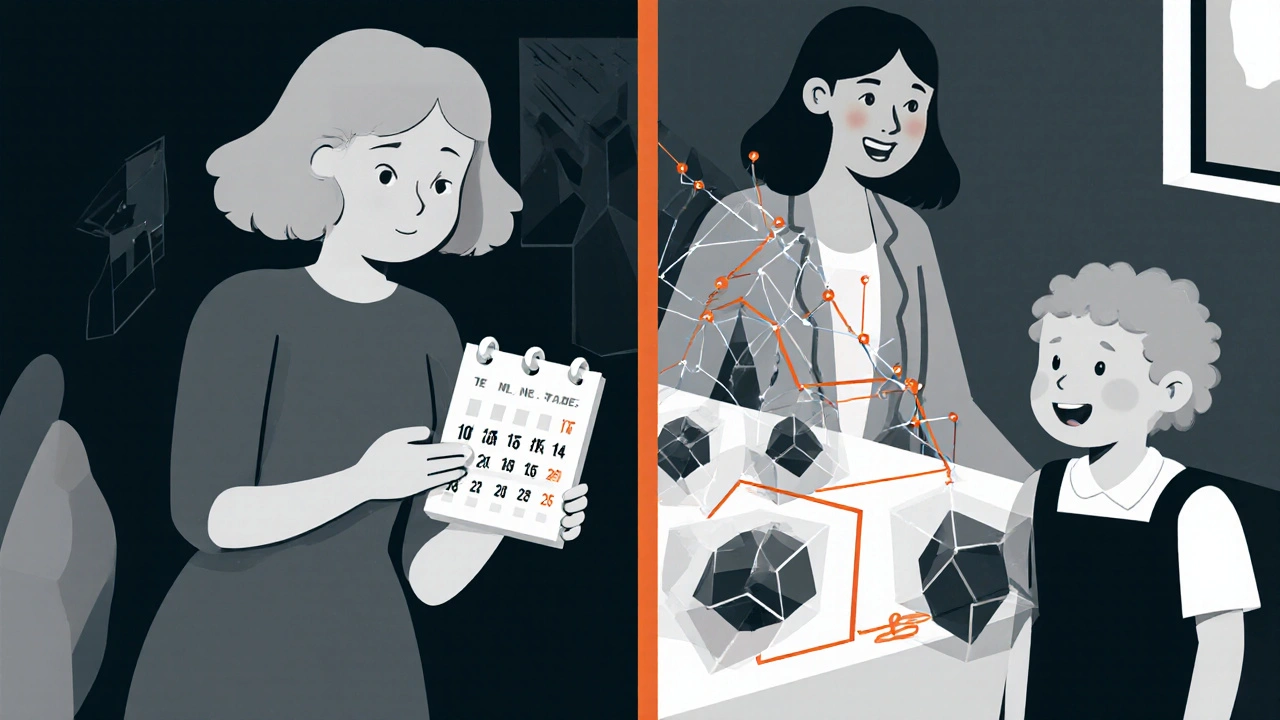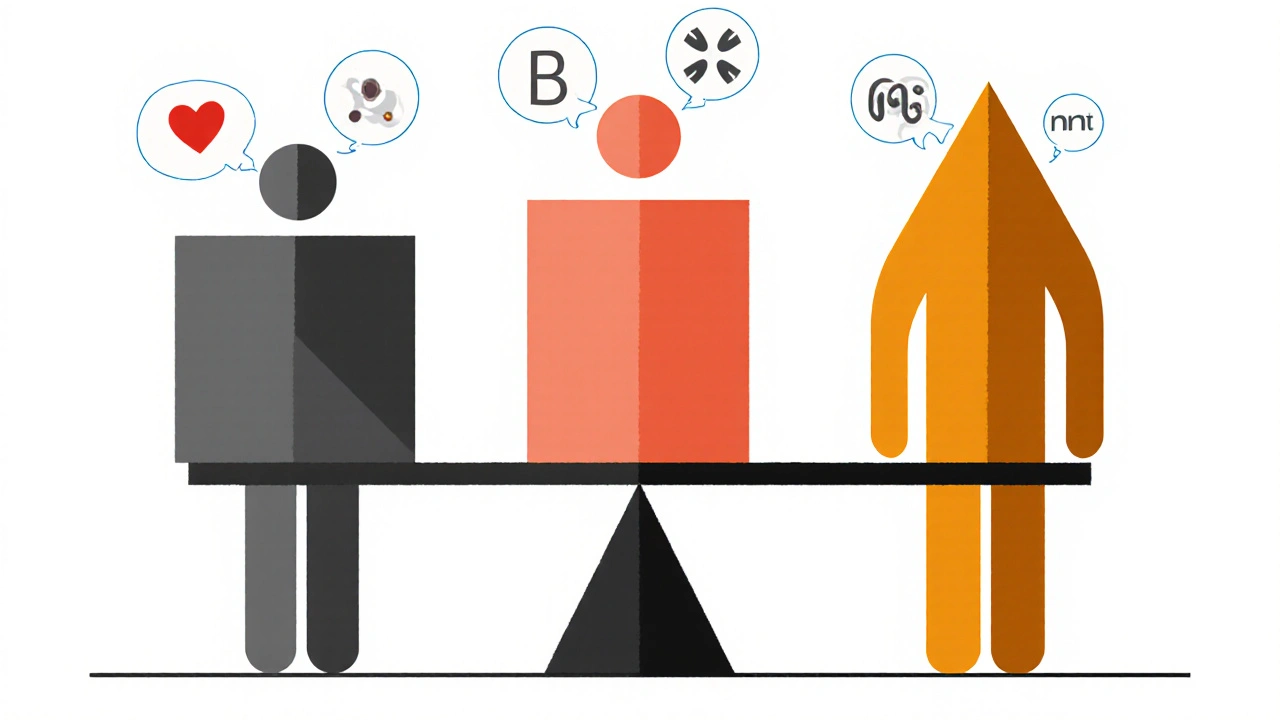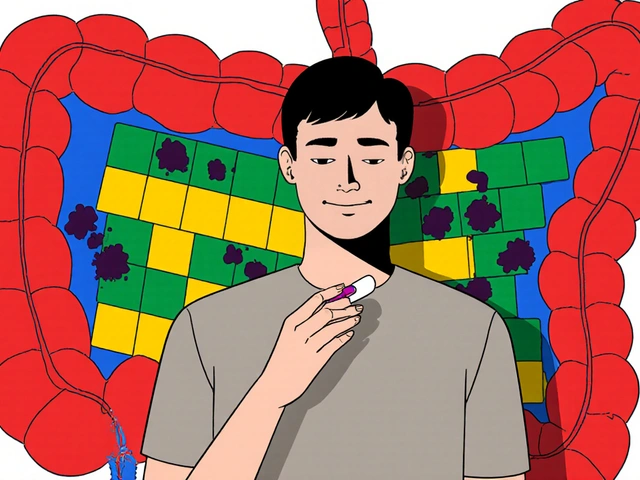When a woman is diagnosed with hormone receptor-positive, HER2-negative advanced breast cancer, the road ahead can feel overwhelming. But in the last decade, one drug has quietly changed the game: ribociclib. It’s not a cure, but for thousands of women, it’s bought them years - not just months - of life with better quality. And the data doesn’t lie.
What Ribociclib Actually Does
Ribociclib is a CDK4/6 inhibitor. That’s a mouthful, but here’s what it means in plain terms: cancer cells in hormone receptor-positive breast cancer rely on two proteins - CDK4 and CDK6 - to multiply like crazy. Ribociclib blocks those proteins, slowing down the tumor’s growth without wiping out healthy cells the way chemo does.
It’s not used alone. It’s always paired with hormone therapy - usually letrozole or fulvestrant. Together, they work like a one-two punch: hormone therapy starves the cancer of estrogen, and ribociclib stops it from using the remaining energy to divide.
The first big trial, MONALEESA-2, followed 668 postmenopausal women with advanced breast cancer. Those who got ribociclib plus letrozole lived a median of 40.9 months without their cancer worsening. The group on hormone therapy alone? Just 27.6 months. That’s more than a year and a half longer before the disease came back.
Survival Rates That Changed Everything
The real game-changer wasn’t just progression-free survival - it was overall survival. In the same MONALEESA-2 trial, after nearly five years of follow-up, 63% of women on ribociclib were still alive. Only 50% of those on hormone therapy alone made it that far.
That’s not a small difference. That’s a 30% reduction in the risk of death. In cancer treatment, that’s huge. And it wasn’t a fluke. The MONALEESA-3 trial, which included premenopausal and perimenopausal women, showed similar results: median overall survival of 53.7 months with ribociclib versus 41.5 months without.
These aren’t statistics on a screen. These are real women - mothers, grandmothers, colleagues - getting to see their kids graduate, attend weddings, or just wake up on a Tuesday without pain.
Who Benefits the Most
Ribociclib isn’t for every type of breast cancer. It only works for hormone receptor-positive, HER2-negative tumors - which makes up about 70% of all advanced breast cancers. That’s the majority, but not everyone.
It’s most effective in postmenopausal women, but studies confirm it also helps premenopausal women when combined with ovarian suppression. Age isn’t the only factor. Women with fewer prior treatments tend to respond better. Those who’ve had multiple rounds of chemo or other targeted therapies often see less benefit.
It’s also not for everyone physically. Ribociclib can lower white blood cell counts, which increases infection risk. Some patients get fatigue, nausea, or liver enzyme changes. Doctors monitor blood work every two weeks in the first two cycles. If your counts drop too low, they’ll pause the drug and adjust the dose.
But for the right patient - healthy enough to tolerate it, with the right tumor type - ribociclib is one of the most powerful tools we have.

How It Compares to Other CDK4/6 Inhibitors
There are two other drugs in the same class: palbociclib and abemaciclib. All three block CDK4/6. But they’re not identical.
Here’s how they stack up:
| Drug | Typical Dosing | Common Side Effects | Median Overall Survival Benefit | Special Considerations |
|---|---|---|---|---|
| Ribociclib | 600 mg daily for 21 days, then 7 days off | Neutropenia, fatigue, nausea, QT prolongation | Up to 12.2 months | Requires ECG monitoring for heart rhythm |
| Palbociclib | 125 mg daily for 21 days, then 7 days off | Neutropenia, fatigue, mouth sores | Up to 9.5 months | Most studied, widely used |
| Abemaciclib | 150 mg twice daily, continuous | Diarrhea, fatigue, elevated liver enzymes | Up to 11.3 months | Can be used alone in some cases |
Ribociclib has the longest survival benefit in head-to-head data. But it also carries a slightly higher risk of heart rhythm changes (QT prolongation), so an ECG is required before starting and after a few weeks. Palbociclib is gentler on the gut but hits blood counts harder. Abemaciclib can be taken continuously and sometimes works where others don’t - but diarrhea can be tough to manage.
The choice isn’t just about which drug works best. It’s about which fits your life. If you’re already on a strict schedule, once-daily dosing might matter. If you have a history of heart issues, your doctor might lean away from ribociclib.
Real-Life Impact Beyond Numbers
One woman in Belfast, diagnosed in 2021 with stage IV breast cancer, started ribociclib with letrozole. She told her oncologist she wanted to see her granddaughter’s first birthday. Three years later, she did. Her tumor shrank. Her energy came back. She’s not cured - but she’s living.
That’s what survival means here. It’s not just about living longer. It’s about living well enough to do the things that matter. Ribociclib doesn’t erase the side effects. But it gives you the time to adapt, to adjust, to find joy again.
For many, it’s turned advanced breast cancer from a terminal diagnosis into a chronic condition - manageable, with regular check-ups, blood tests, and a daily pill.

What Comes Next
Research is already moving beyond ribociclib. Scientists are testing combinations with newer hormone drugs, immunotherapies, and even drugs that target specific genetic mutations like PIK3CA. Trials are underway to see if ribociclib can help earlier - even in stage II breast cancer, after surgery, to prevent recurrence.
But right now, for women with advanced hormone-positive breast cancer, ribociclib is one of the most reliable tools we have. It’s not perfect. It’s not cheap. But it works - and it gives people back something they thought they’d lost: time.
Is ribociclib a chemotherapy drug?
No, ribociclib is not chemotherapy. It’s a targeted therapy that blocks specific proteins (CDK4/6) cancer cells need to grow. Unlike chemo, which attacks rapidly dividing cells throughout the body, ribociclib is more precise. It doesn’t cause hair loss or severe nausea in most people, though it can lower white blood cell counts.
How long do people typically stay on ribociclib?
There’s no fixed end date. Most patients stay on ribociclib as long as it’s working and side effects are manageable. Some stay on it for years. Treatment stops if the cancer starts growing again, if side effects become too severe, or if the patient decides to stop. Regular scans and blood tests help doctors decide when to continue or switch.
Can ribociclib be used for early-stage breast cancer?
Not yet as a standard treatment. But clinical trials are testing ribociclib in earlier stages - like after surgery for high-risk stage II or III hormone-positive breast cancer. Early results suggest it may reduce the chance of recurrence. It’s not approved for this use yet, but it could be in the next few years.
What are the biggest risks of taking ribociclib?
The most common serious risk is neutropenia - low white blood cell count - which increases infection risk. Regular blood tests are required. Ribociclib can also affect heart rhythm (QT prolongation), so an ECG is needed before starting and after a few weeks. Liver function changes and fatigue are also common. Most side effects are manageable with dose adjustments.
Is ribociclib covered by insurance?
In most countries, including the UK, ribociclib is covered by national health services for eligible patients with advanced hormone receptor-positive, HER2-negative breast cancer. In the U.S., most private insurers cover it, but prior authorization is usually required. Patient assistance programs are available from the manufacturer for those without coverage.
Final Thoughts
Ribociclib didn’t come out of nowhere. It was built on decades of research into how cancer cells divide. And now, it’s helping women live longer, fuller lives than ever before.
It’s not magic. It’s science - hard, careful, tested science. And for those facing advanced breast cancer, that’s something to hold onto.







Liv Loverso
November 2, 2025 AT 09:33Ribociclib isn't just a drug-it's a rebellion against the idea that advanced cancer means a death sentence. They used to say 'live months,' now we say 'plan for years.' That shift? That's science with soul. And yet, the system still makes it a luxury. How is it that we can engineer molecules to outsmart cancer but can't make them accessible to everyone who needs them?
Steve Davis
November 2, 2025 AT 13:17Okay but let’s be real-how much of this is just Big Pharma spinning gold out of desperation? I mean, sure, it extends life, but at what cost? The side effects alone could kill your quality of life faster than the cancer. And don’t get me started on the price tag. This isn’t medicine-it’s a subscription service for the rich.
Attila Abraham
November 2, 2025 AT 16:47Man I just want to hug every doctor who prescribes this stuff. Seriously. I’ve seen people come back from the edge with this. Not cured, sure-but alive. Laughing. Cooking. Watching their grandkids grow. That’s not just data. That’s damn near miracles in pill form. Keep fighting the good fight.
Michelle Machisa
November 4, 2025 AT 04:03I had a patient on ribociclib for 4 years. She traveled to Japan, adopted a cat, started a blog. Her tumor stabilized. She didn’t die. That’s the win. Side effects? Yeah, they’re real. But you adjust. You work with your team. This isn’t the end-it’s a new chapter. And chapters matter.
Ronald Thibodeau
November 4, 2025 AT 11:46Look I get it, it works, but why do we keep acting like this is the first breakthrough ever? We had tamoxifen in the 80s. We had aromatase inhibitors. This is just the latest flavor. And honestly? The survival numbers are inflated because they cherry-pick patients who are already healthy enough to tolerate it. Real-world results? Less glamorous.
Shawn Jason
November 6, 2025 AT 08:54I keep thinking about what it means to extend life without curing it. Is that mercy? Or just postponing the inevitable? Ribociclib gives time-but time with side effects, with scans, with fear of the next result. We celebrate the extension, but do we ever ask if the quality of that extension is what the patient truly wanted? Maybe we’re just delaying grief with fancy pills.
Monika Wasylewska
November 7, 2025 AT 04:20My aunt took it for 3 years. She worked part-time. Watched cricket. Made samosas. Didn’t lose her hair. That’s the real win. No drama. Just living. This drug doesn’t promise miracles. Just more days. And sometimes, that’s enough.
Jackie Burton
November 8, 2025 AT 20:17Let’s not ignore the elephant in the room: ribociclib’s QT prolongation risk is a ticking time bomb. The FDA warnings? Barely enforced. And the pharma reps? They downplay it. Meanwhile, patients are getting arrhythmias and dying because their ECGs weren’t monitored properly. This isn’t innovation-it’s a liability wrapped in a clinical trial.
Philip Crider
November 10, 2025 AT 12:02Bro this drug is like the Netflix of cancer treatment 🤝 You get your subscription, you binge the time, you don’t die immediately, and you still get to watch your kid’s soccer game 😎 I mean, imagine being able to see your daughter graduate? That’s not science, that’s magic. And yeah, the side effects suck-but so does dying at 52. Choose the side effects. I dare you.
Diana Sabillon
November 10, 2025 AT 23:34I lost my mom to breast cancer before this was an option. I just wish she’d had this. Not because she’d be alive today-but because she’d have had more quiet mornings, more hugs, more tea with the grandkids. That’s what this drug gives. Not a cure. But more of what matters.
neville grimshaw
November 12, 2025 AT 11:04Oh for god’s sake, another glowing piece about Big Pharma’s latest cash cow. Ribociclib? Please. It’s just a fancy version of chemo with a better PR team. And the survival stats? They’re measured in ‘progression-free survival’-which means the cancer didn’t grow… yet. It’s still there. Still hungry. Still waiting. This isn’t hope-it’s a temporary reprieve dressed up as a victory.
Carl Gallagher
November 13, 2025 AT 00:46I’ve been following CDK4/6 inhibitors since the first trials. The real breakthrough isn’t just ribociclib’s survival numbers-it’s the fact that we’re finally treating advanced breast cancer like a chronic disease instead of a death sentence. It’s not perfect. It’s not cheap. But it’s a paradigm shift. And we’re still learning. The next decade will bring even better combos-maybe even with immunotherapy. This is just the beginning of a new era in oncology.
bert wallace
November 14, 2025 AT 02:52My brother’s oncologist switched him from palbociclib to ribociclib after his counts crashed. Within weeks, his tumor markers dropped. He’s been on it for 2.5 years. No hair loss. No vomiting. Just fatigue and a monthly blood test. That’s a win. The side effects are manageable. The alternative? Not being here to see your kid turn 16. That’s not a choice.
Neal Shaw
November 14, 2025 AT 21:50Let’s clarify a common misconception: ribociclib does not inhibit CDK6 as effectively as CDK4. Its binding affinity is higher for CDK4, which is why it’s more potent in ER+ tumors. The MONALEESA trials showed a statistically significant OS benefit (HR 0.71, p<0.001) compared to hormone therapy alone. The QT prolongation risk is dose-dependent and mitigated with baseline and follow-up ECGs. This is not experimental-it’s standard of care for eligible patients.
Hamza Asghar
November 15, 2025 AT 15:33Let’s be honest-ribociclib’s only ‘advantage’ is that it’s newer and more expensive than palbociclib. The survival difference? Barely clinically meaningful. And the QT risk? A nightmare for geriatric patients. Why are we pushing this over the cheaper, safer option? Because the pharmaceutical reps have better dinners with oncologists. This isn’t medicine-it’s a marketing war disguised as science.
Karla Luis
November 16, 2025 AT 08:17My sister’s on it. She says the fatigue is brutal but worth it. She’s been to three weddings since diagnosis. One was her niece’s. She danced. That’s the real metric. Not months. Not survival curves. Dancing.
jon sanctus
November 16, 2025 AT 09:58Oh wow, another article that makes cancer sound like a Netflix binge. Ribociclib? Sure. But have you talked to the people who actually live with it? The constant blood draws. The fear every time they get a fever. The insurance battles? This isn’t hope. It’s a high-stakes gamble with your body as the chip.
Kenneth Narvaez
November 17, 2025 AT 20:03CDK4/6 inhibitors show median OS benefit of 10-12 months in HR+/HER2- advanced BC. Ribociclib’s hazard ratio is 0.71 in MONALEESA-2. But real-world adherence is only 68% due to toxicity. The economic burden exceeds $150k/year/patient. This is not scalable without systemic reform.
Christian Mutti
November 19, 2025 AT 15:13It is with profound reverence that I acknowledge the monumental strides in oncological science embodied by ribociclib. This pharmaceutical marvel, born of decades of meticulous research, has redefined the boundaries of possibility for those facing the most harrowing of diagnoses. To witness a woman, once told she had mere months, now celebrating her granddaughter’s first birthday-this is not merely medicine. It is the triumph of human ingenuity over the inevitability of fate. 🙏✨